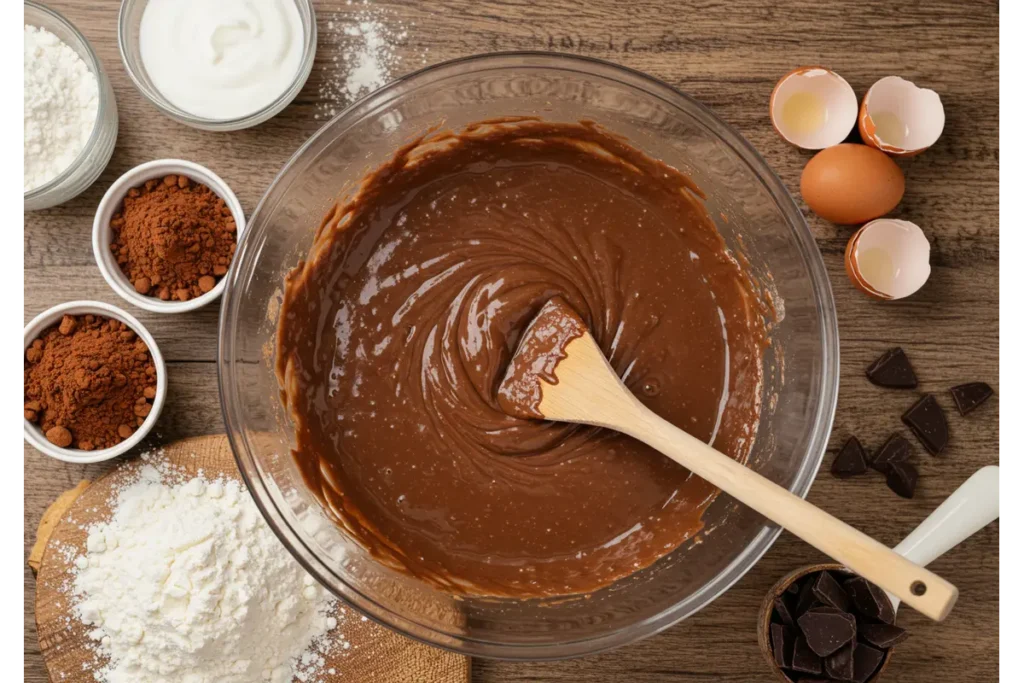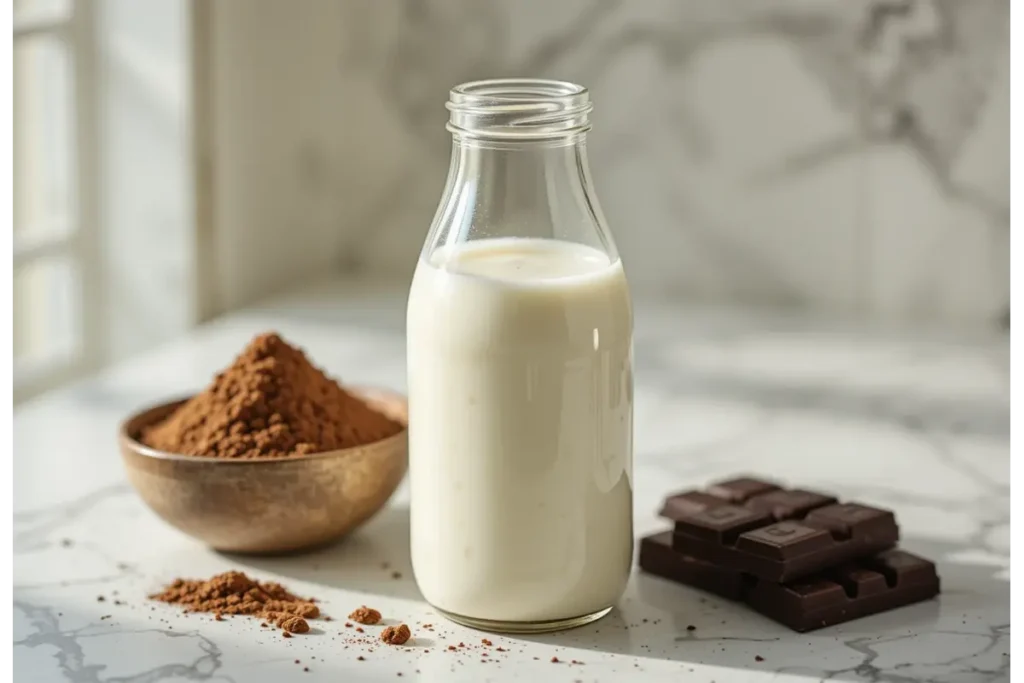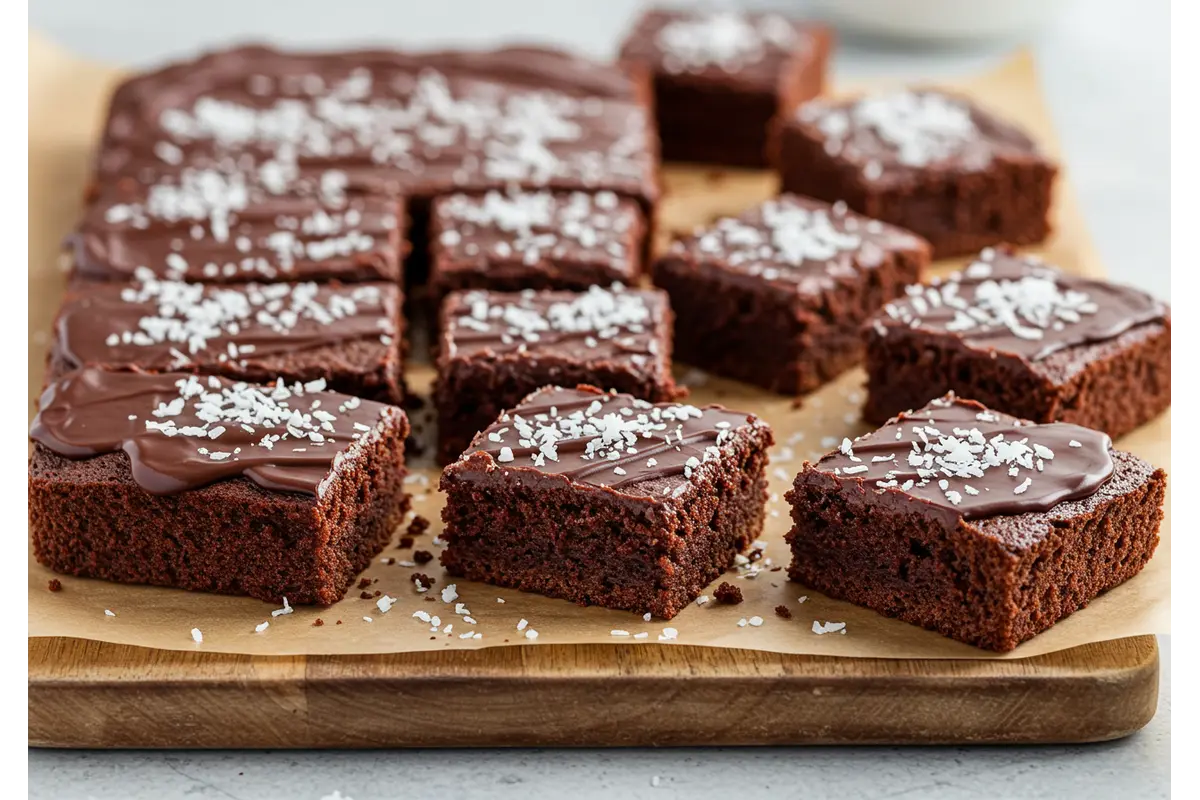Chocolate kefir sheet cake recipe card is the ultimate indulgence—rich, moist, and packed with flavor. If you love baking with fermented dairy products, this easy one-bowl recipe is a must-try! Using kefir instead of milk or buttermilk gives the cake an ultra-tender crumb while adding a subtle tanginess that balances the deep chocolate flavors.
But why choose kefir over traditional dairy? Unlike regular milk, kefir is loaded with probiotics, making it a gut-friendly choice for baking. Studies suggest that kefir may improve digestion and enhance nutrient absorption in baked goods.
Another key to this cake’s indulgent texture is the chocolate glaze, which adds a silky richness on top. The trick to achieving the perfect glossy finish is properly melting chocolate—a process that can make or break your glaze. If you struggle with melting chocolate, this step-by-step guide will help you achieve a perfectly smooth consistency every time.
Table of Contents
Why Bake with Kefir? A Flavorful & Healthy Choice
When it comes to baking, the liquid ingredients you choose can make a huge difference in both texture and flavor. Kefir is a fermented dairy product that not only enhances the richness of baked goods but also provides several health benefits that make it stand out from traditional options like milk or buttermilk.
Here’s why baking with kefir is an excellent choice:
1. Adds Moisture Without Extra Fat
One of the most important qualities of a great cake is its moisture content. Dry cakes can be disappointing, but adding kefir helps lock in hydration without the need for excessive butter or oil. The natural composition of kefir allows it to bind with dry ingredients more effectively, leading to a soft, tender crumb that stays moist for days.
2. Enhances the Chocolate Flavor
Kefir’s slightly tangy taste works wonders in desserts by balancing out the richness of deep chocolate flavors. Similar to how coffee enhances chocolate, kefir adds complexity to the taste, preventing it from being overly sweet or one-dimensional. The result? A cake with a more intense, well-rounded chocolate experience.
3. Supports Gut Health & Digestion
Unlike regular milk or buttermilk, kefir is a probiotic powerhouse, filled with beneficial bacteria that promote gut health. These probiotics aid digestion by breaking down lactose, making kefir a better option for those with mild lactose intolerance. Plus, these good bacteria help support a healthy gut microbiome, which has been linked to better immunity and improved digestion.
4. A Versatile Substitute for Buttermilk or Yogurt
If you typically bake with buttermilk or Greek yogurt, you’ll love using kefir as a direct 1:1 substitute. It brings the same tanginess and acidity to the batter, ensuring baked goods rise properly while maintaining a light and fluffy texture. Unlike buttermilk, which can sometimes be too thick, kefir has a pourable consistency, making it easier to mix into cake batters and other baked goods.
5. Helps Activate Baking Soda for a Fluffy Cake
One of kefir’s hidden superpowers is its acidity, which plays a crucial role in baking. When combined with baking soda, it triggers a chemical reaction that produces carbon dioxide bubbles, giving your cake an incredibly light and airy texture. This is why recipes using kefir often require baking soda instead of baking powder—the acidity naturally acts as a leavening agent.
6. Naturally Enhances the Nutritional Value of Your Cake
Beyond its role in improving texture and flavor, kefir also brings nutritional benefits to the table:
- Rich in calcium & protein – Strengthens bones and muscles.
- Packed with probiotics – Supports gut health and digestion.
- Contains B vitamins – Helps with energy production and metabolism.
- Lower in lactose – Easier to digest than traditional dairy.
If you love experimenting with fermented dairy in desserts, check out this kefir cake recipe for another flavorful twist!
Ingredients for Chocolate Kefir Sheet Cake Card

For the Cake:
- 2 cups all-purpose flour
- 1 ¼ cups granulated sugar
- 2 cups kefir (or buttermilk)
- 1 medium egg
- 3 tablespoons unsweetened Dutch cocoa powder
- 1 teaspoon baking soda
- ½ cup sunflower or canola oil
For the Chocolate Glaze:
- 1 cup dark or semi-sweet chocolate chips
- ⅓ cup heavy cream
- Shredded coconut (optional, for topping)
Step-by-Step Instructions
1. Prepare the Baking Sheet
- Preheat your oven to 340°F (170°C).
- Grease a 9×13-inch baking sheet with oil and dust it with breadcrumbs.
2. Mix the Batter
- In a large bowl, whisk together the kefir and oil.
- Add the egg, sugar, and cocoa powder and stir until smooth.
- Gradually mix in the flour and baking soda. The batter should be slightly thick but pourable.
3. Bake the Cake
- Pour the batter into the prepared pan and smooth it out with a spatula.
- Bake for 20 minutes, or until a toothpick inserted in the center comes out clean.
- Let the cake cool completely before adding the glaze.
4. Prepare the Chocolate Glaze
- In a heatproof bowl, melt the chocolate chips using a double boiler.
- Stir in the heavy cream until smooth and glossy.
- Pour the glaze evenly over the cooled cake and spread with a spatula.
5. Add Finishing Touches & Serve
- Sprinkle shredded coconut over the top for a decorative touch.
- Let the glaze set for about 15 minutes before slicing into squares.
Pro Tips for the Perfect Chocolate Kefir Cake Card
Baking a cake isn’t just about following a recipe—it’s about knowing the little tricks that make all the difference between a good cake and a spectacular one. Here are some expert tips to ensure your chocolate kefir sheet cake turns out fluffy, moist, and full of flavor every time.

Use Baking Soda, Not Baking Powder
One of the biggest mistakes people make when baking with kefir is using baking powder instead of baking soda. While both are leavening agents, baking soda works best with kefir because of its acidity. Here’s why:
- Kefir has natural lactic acid, which reacts with baking soda (sodium bicarbonate) to create carbon dioxide bubbles. These bubbles expand in the heat of the oven, making the cake light and airy.
- Baking powder contains its own acid, so it doesn’t need an acidic ingredient like kefir. However, it won’t create as much rise as baking soda in this recipe.
- If you accidentally use baking powder instead of baking soda, your cake may not rise properly or could develop a slightly bitter aftertaste.
So, stick with baking soda to get the best texture and rise!
Don’t Overmix the Batter
It’s tempting to keep mixing until the batter looks perfectly smooth, but doing so can actually ruin the texture of your cake. Here’s what happens when you overmix:
- Too much gluten develops. Flour contains proteins that form gluten when mixed with liquids. Overmixing causes these proteins to tighten up, leading to a dense, chewy cake instead of a soft and tender one.
- The air bubbles collapse. The chemical reaction between kefir and baking soda starts as soon as they mix. Overmixing breaks the air bubbles, making your cake less fluffy.
How to avoid overmixing:
- Mix just until the ingredients are combined—no more.
- If you see a few tiny lumps in the batter, that’s fine! They’ll dissolve during baking.
Want a Juicier Cake? Brush the Top with Fruit Jam
If you love extra-moist cakes, try brushing a thin layer of fruit jam over the cake before adding the chocolate glaze. This simple trick can:
- Lock in extra moisture and prevent the cake from drying out.
- Add a subtle fruity sweetness that pairs beautifully with rich chocolate.
- Enhance the flavor profile with options like raspberry, apricot, or orange marmalade.
Best jam pairings for chocolate cake:
- Raspberry jam – Adds a tangy contrast to the chocolate.
- Apricot preserves – A subtle sweetness that complements kefir’s tartness.
- Orange marmalade – Pairs well with dark chocolate for a citrusy twist.
Store Leftovers Properly for Maximum Freshness
No one likes stale cake, so proper storage is key to keeping your chocolate kefir cake fresh and delicious for days.
- At room temperature: Store in an airtight container for up to 3 days. The cake will stay soft, but if your kitchen is humid, it may absorb moisture and become sticky.
- In the refrigerator: If you need to store it longer, refrigerate it for up to a week. However, refrigeration can dry out cakes, so wrap it tightly in plastic wrap before placing it in an airtight container.
- In the freezer: For long-term storage, wrap the cake in two layers of plastic wrap, then place it in a freezer-safe bag. It will stay fresh for up to 3 months. To thaw, leave it at room temperature for a few hours before serving.
Pro Tip: If your cake becomes dry after refrigeration, microwave individual slices for 10–15 seconds to restore moisture!
Try Different Toppings for a Unique Twist
While the classic chocolate glaze + shredded coconut combo is delicious, don’t be afraid to get creative with your toppings!
- Chopped Nuts: Add crunch and a nutty flavor. Try toasted almonds, pecans, or walnuts.
- Chocolate Shavings or Sprinkles: For extra chocolatey goodness and a fun presentation.
- Fresh Berries: Raspberries, strawberries, or blueberries add color and a fruity contrast.
- Citrus Zest: Grated orange or lemon zest enhances the chocolate flavor with a bright, citrusy aroma.
- Mint Leaves: For a fresh, cooling effect that pairs well with chocolate.
Want more chocolate-based desserts? Check out this perfect chocolate shortbread recipe for a crunchy, buttery treat that pairs perfectly with your chocolate kefir cake!
Variations & Substitutions
If you want to customize this chocolate kefir cake, here are some great variations:
- Gluten-Free: Use gluten-free all-purpose flour instead of wheat flour.
- Dairy-Free: Replace kefir with coconut milk kefir and use dairy-free chocolate for the glaze.
- Sugar-Free: Swap granulated sugar with monk fruit sweetener or coconut sugar.
- Extra Rich: Add ½ cup of melted dark chocolate into the batter for an intense chocolate flavor.
- Spiced Chocolate Cake: Mix in ½ teaspoon of cinnamon or a pinch of chili powder for a warm, spicy kick.
Serving Suggestions
Pair this chocolate kefir cake with:
- A warm cup of coffee or chai tea for a cozy treat.
- A glass of almond or oat milk for a dairy-free option.
- A side of vanilla ice cream for an indulgent dessert.
For a fun breakfast option, try this fluffy almond milk pancake recipe—another great way to enjoy fermented dairy-based treats!
Frequently Asked Questions (FAQs)
Q: Can I use buttermilk instead of kefir?
A: Yes! Buttermilk works as a great substitute for kefir, but it has fewer probiotics.
Q: Why is my chocolate glaze too runny?
A:If the glaze is too thin, try adding more melted chocolate or letting it cool slightly before spreading it on the cake.
Q: Can I make this cake without eggs?
A: Absolutely! Replace the egg with ½ cup of unsweetened applesauce or a flaxseed egg substitute.
Q: How do I make the cake even more chocolatey?
A: Use extra dark cocoa powder and add chocolate chunks to the batter.
Final Thoughts
This chocolate kefir sheet cake is an easy, foolproof recipe that brings together rich chocolate flavors and the benefits of fermented dairy. Whether you’re baking for a family gathering or just want a quick, satisfying dessert, this cake delivers moist, delicious goodness in every bite.
Want more creative ways for baking? Check out this for more flaky, buttery treats or this christmas bark recipe or this almond croissant cookies.
So, are you ready to bake your own chocolate kefir cake? Let us know how it turns out in the comments!
PrintChocolate Kefir Sheet Cake Recipe Card: A Moist & Delicious Treat
This chocolate kefir sheet cake is a rich, moist, and easy-to-make dessert. The kefir adds a soft texture and a hint of tanginess, while the chocolate glaze creates the perfect finishing touch.
- Prep Time: 10 minutes
- Cooling Time: 30 minutes
- Cook Time: 20 minutes
- Total Time: 1 hour
- Yield: 15 pieces 1x
- Category: Dessert
- Cuisine: European, Czech
Ingredients
For the Cake:
- 2 cups all-purpose flour
- 1 ¼ cups granulated sugar
- 2 cups kefir (or buttermilk)
- 1 medium egg
- 3 tablespoons unsweetened Dutch cocoa powder
- 1 teaspoon baking soda
- ½ cup sunflower or canola oil
For the Chocolate Glaze:
- 1 cup dark or semi-sweet chocolate chips
- ⅓ cup heavy cream
- 3 tablespoons shredded coconut (optional, for topping)
Instructions
1. Prepare the Baking Pan
- Preheat your oven to 340°F (170°C).
- Grease a 9×13-inch baking sheet with oil and dust with breadcrumbs.
2. Mix the Batter
- In a bowl, whisk together kefir and oil.
- Add the egg, sugar, and cocoa powder and mix well.
- Gradually stir in flour and baking soda until fully combined.
3. Bake the Cake
- Pour the batter into the prepared pan and smooth it out with a spatula.
- Bake for 20 minutes, or until a toothpick inserted in the center comes out clean.
- Let the cake cool completely before glazing.
4. Make the Chocolate Glaze
- Melt chocolate chips using a double boiler or microwave in short bursts.
- Stir in heavy cream until smooth and glossy.
5. Decorate & Serve
- Pour the glaze evenly over the cake and spread with a spatula.
- Sprinkle shredded coconut (optional) and let it set for 15 minutes.
- Slice into squares and enjoy!
Notes
Use baking soda, not baking powder – it reacts with kefir to create a light texture.
For a juicier cake, brush a layer of fruit jam before adding the chocolate glaze.
Storage Tips: Keep in an airtight container at room temperature for 3 days or refrigerate for up to a week.
Nutrition
- Serving Size: 1
- Calories: 385 kcal
- Sugar: 32g1g
- Fat: 19g
- Saturated Fat: 7g
- Carbohydrates: 50g
- Fiber: 1g
- Protein: 5g
Keywords: Chocolate kefir cake, kefir sheet cake, moist chocolate cake, probiotic cake recipe

